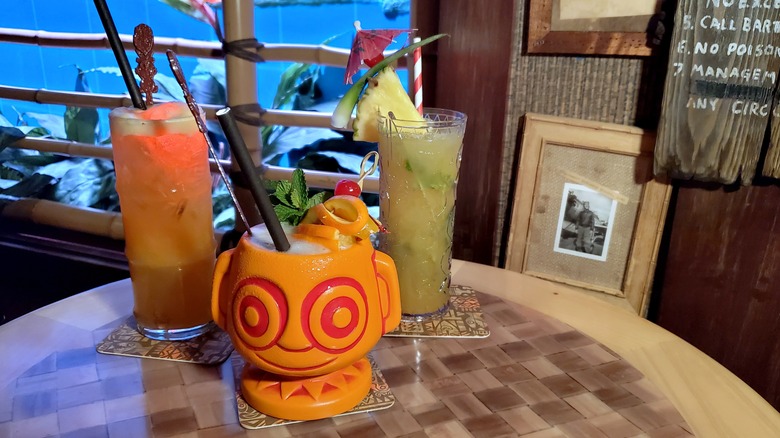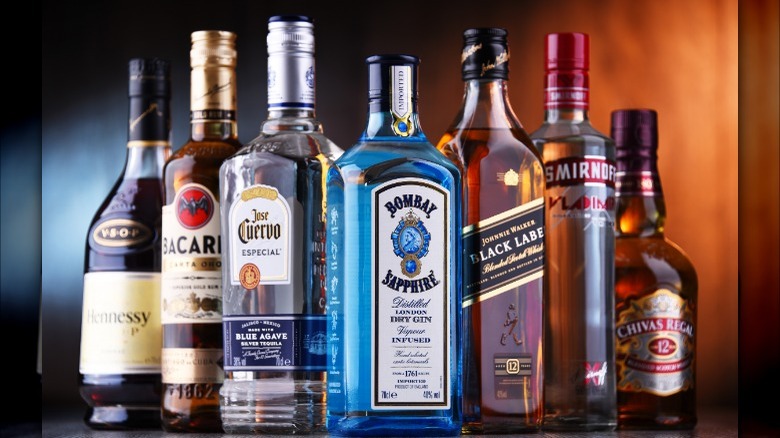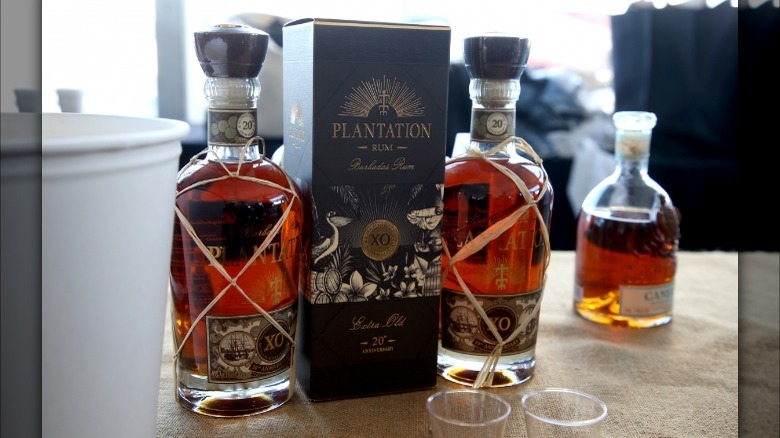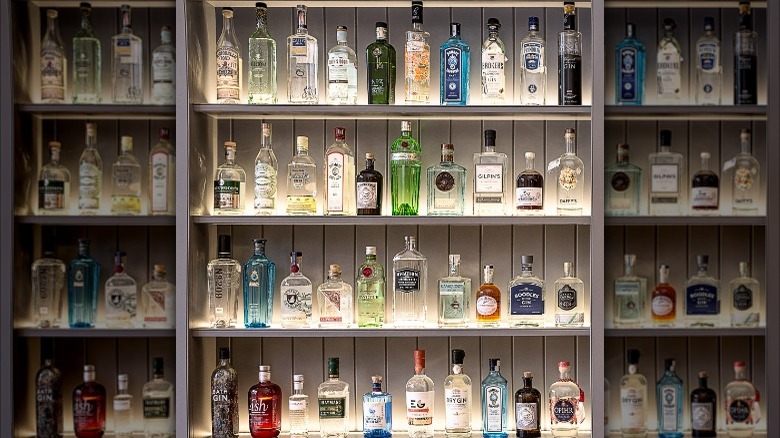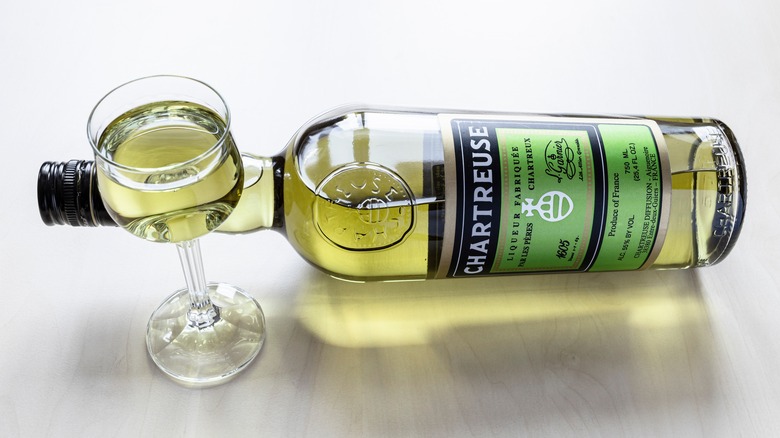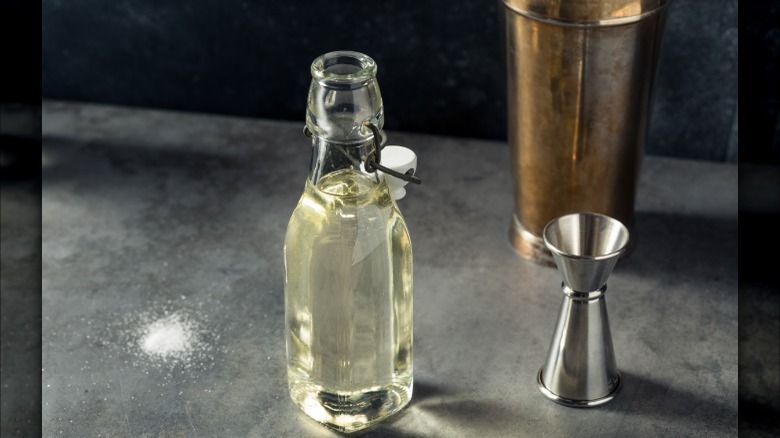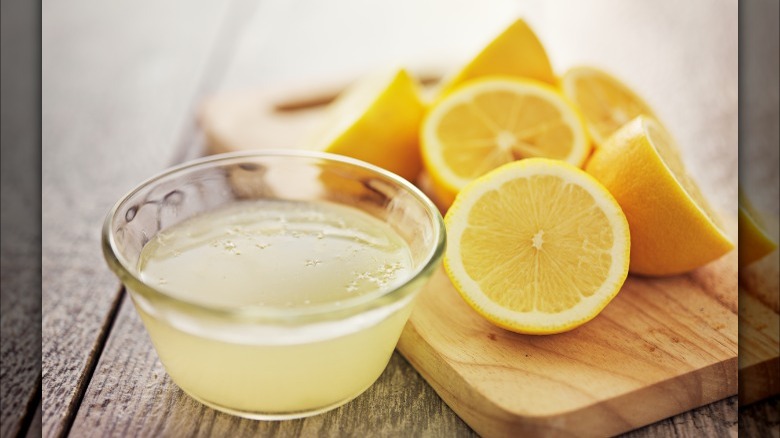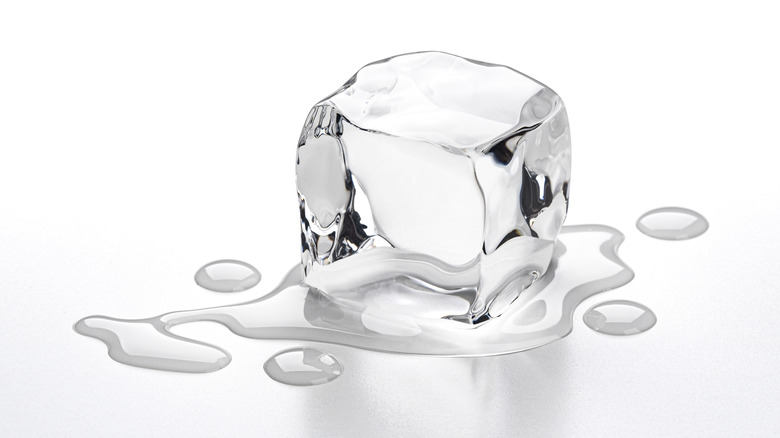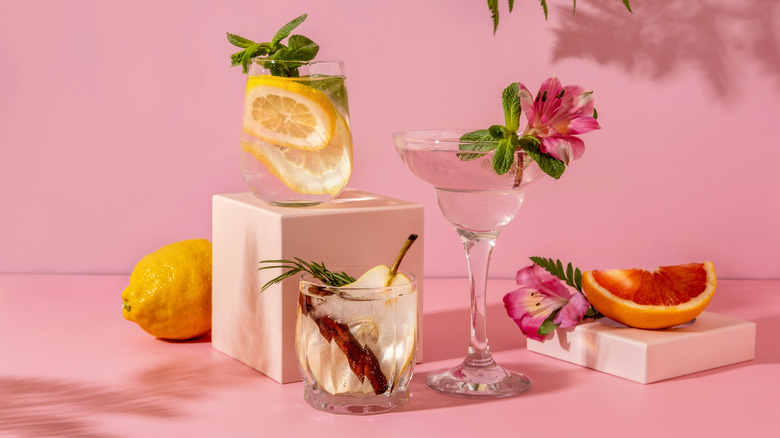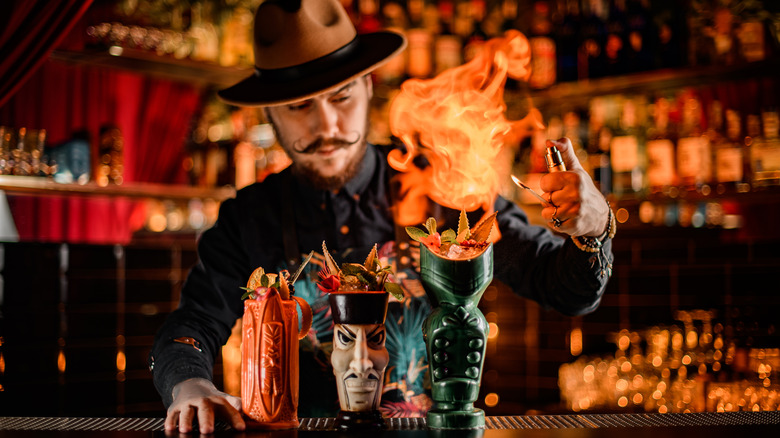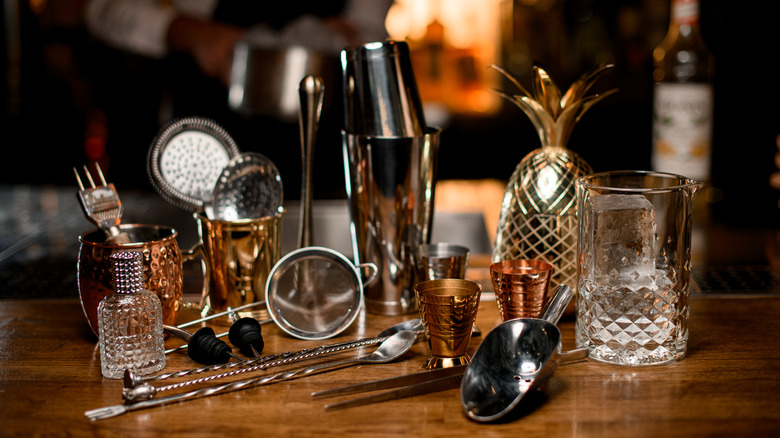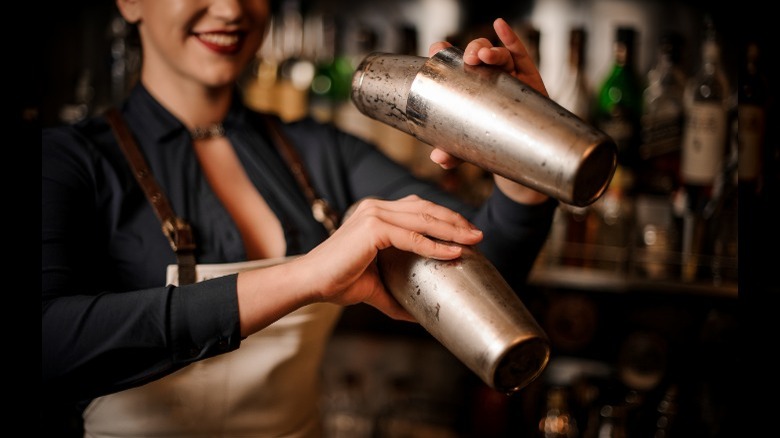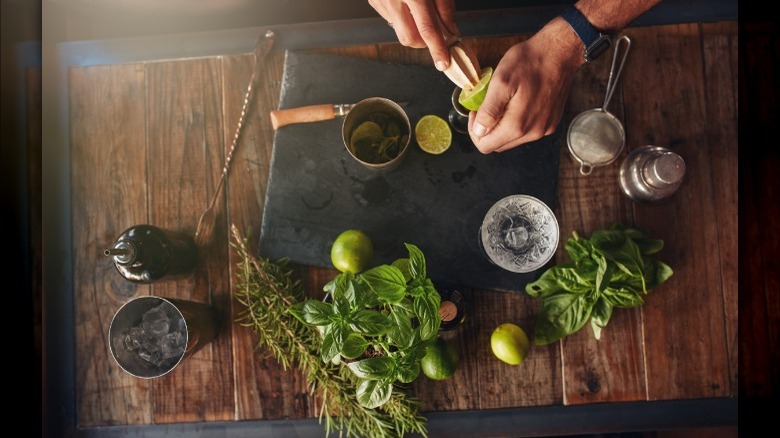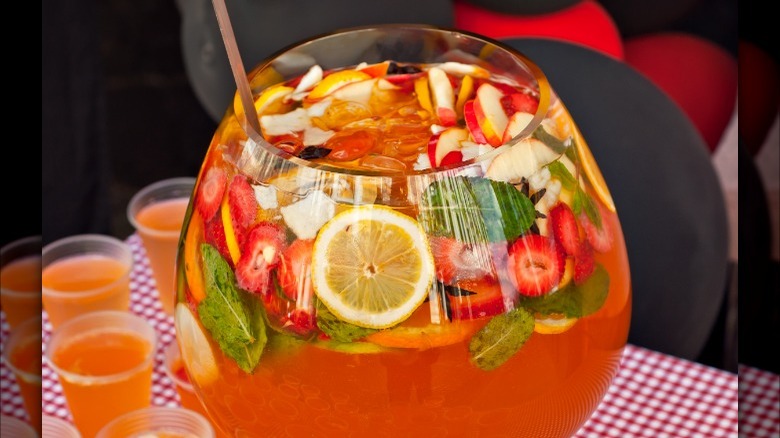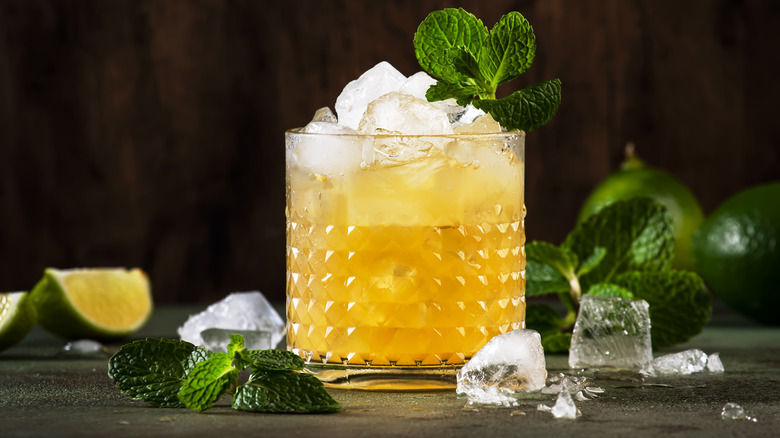14 Essential Tips For Making Tiki Drinks, According To A Trader Sam's Mixologist - Exclusive
Every year, Disney California Adventure hosts its Food and Wine Festival in March and April. People come from all over just to eat and drink their way through the amusement park. For a nominal fee, you can purchase a Sip & Savor Pass which allows you to sample eight dishes between rides and character meetups. But the Festival Marketplace isn't the only reason people flock to the Disney Resort. During these eight weeks, Disney also has several bookable experiences that patrons can participate in.
There's everything from wine receptions to mixology classes. Each one focuses on a specific topic and anyone can go ... as long as you book the experience in advance and have a ticket to the park, as several of them take place inside Disney California Adventure. One of the more popular choices is the mixology class hosted by the bartenders from Trader Sam's Enchanted Tiki Bar. Students learn about tiki drinks as well as how to make Trader Sam's famous HippopotoMai-Tai. Then they get to enjoy the cocktail along with a few of Sam's popular hors d'oeuvres. They even get to take home the HippopotoMai-Tai mug ... a very popular mug among Sam's patrons that's currently in its fourth rendition.
Since Trader Sam's is such a popular bar with wait times usually extending well over an hour, we spoke to Trader Sam's own Cristian Diaz, aka Skipper Cristian, about what makes a great tiki cocktail and how amateur bartenders can create their own tropical drinks at home.
Five liquors every home bar should have
Diaz strongly believes that every home bar should have at least five liquors. "There is what we call your well or your speed rack or whatnot," says Diaz. "That entails the basic five that you need in every single bar, in every single place, across the land." Those five liquors are vodka, rum, gin, tequila, and whiskey. "It does not matter which ones," he continues. "Hopefully you have a favorite already in mind, but you normally want to start with something on the low end and then build up from there." When Diaz says low, he means liquor at a lower price point — in other words, liquor that you don't mind sharing or using to mix up cocktails.
Even though those five liquors are the ones Trader Sam's (and all other bars around the world) stock, setting up your bar at home should reflect what you like to drink. "If he's a tiki guy, there's going to be a lot of rum, there's going to be a lot of different types of spirits, and bitters and different syrups of all kinds," Diaz explains. "If he's more of your Prohibition-style bartender, then there's going to be lots of different kinds of ice. Lots and lots of different kinds of bitters. There's going to be lots of gin and whiskey everywhere and probably some cognac. So, it just depends."
Pick the best rum
If you look at the shelves behind the bar at Trader Sam's, you'll notice an array of rum. There are white rums and dark rums. Some are in tall, skinny bottles, while others are covered in raffia. Some of the labels are bright and colorful while others are simple and plain. Even with all these rums at Skipper Cristian's fingertips, he still has his favorites, as well as rums that he thinks every home bartender should stock if they want to make a really good tiki drink.
"Plantation Dark. Rhum Clement VSOP," he says as he pulls each bottle out and places it on the bar. "If we're gonna go for a light rum, I'd say maybe a nice Real McCoy. Real McCoy 3 or 5 [year]. Those are great. And ... oh yeah!" Diaz shouts with excitement. "Plantation Bajan rum. I love their Bajan rum." Diaz admits he really likes Plantation. "They have a lot of styles and they're all great."
Rum isn't the only liquor to use
While rum is usually the main spirit in most tiki drinks, there are several that don't use any rum at all. It's for this reason that Diaz suggests having some whiskey and gin behind the bar as well. "Gin is becoming very popular in the tiki world. We use it a lot," he says as he adds some rum to a shaker tin. "We do things like Saturns, and a Suffering Bastard is an old tiki cocktail that has gin. So, gin is something that is very much an essential for a tiki bar," Diaz explains.
Gin and whiskey are the harder liquors, but you want to stock some lower alcohol-by-volume spirits as well — liqueurs like Falernum, a rum-based liqueur with hints of citrus and spice. John D. Taylor's Velvet Falernum is the most popular Falernum out there, coming in at only 11% ABV.
Stock a few underrated liquors in your bar
So now we know that rum is the most important liquor for tiki cocktails and that gin and whiskey are common choices these days as well. But Diaz says there are also some more unusual bottles you should have.
Chartreuse is a big one, both yellow and green. "Green over yellow, always," says the skipper. "But both. It's good to have both." The one thing to keep in mind with Chartreuse is that the green and yellow liqueurs are becoming harder to find. Even though the consumption of Chartreuse has soared in recent years, the monks behind the centuries-old secret recipe have opted not to increase production. So, if you see either the yellow or green liqueur, grab it.
Along with Chartreuse, Diaz also recommends stocking Luxardo cherry liqueur, Campari, Cynar, absinthe, and St. Germaine, the elderflower liqueur, in your bar as well.
Make your own syrups
Simple syrup is one of the most common mixers in the cocktail world. A one-to-one mixture of sugar and water, it's often used to add sweetness to the drink. Plain simple syrup is the most common choice for cocktails, and Diaz says it's an absolute necessity to have in your bar. But there are several flavored syrups as well, like cinnamon, passionfruit, and orgeat (an almond-based syrup). While you can purchase all of these at various liquor specialty stores, Diaz recommends making your own. "You want to get out there, you want to learn how to make those syrups so you can save yourself some money, or go out and purchase them."
Diaz says it's not terribly difficult to make these syrups yourself. "It's actually pretty easy. You just need to, you know, open up a browser, and download a recipe." And Diaz has plenty that he's happy to share. He has a YouTube Channel, Adventures with Alchemy, where he shows the tips and tricks to make most of the classic tiki syrups including orgeat, passionfruit, and Falernum.
While those are the most common syrups you'll find at a tiki bar, there are a couple of specialty syrups you could add to your bar like Fassionola and Gardena, which Diaz describes as more akin to a batter than a syrup. These two syrups are for specific tiki drinks like the Cobra's Fang and the Polynesian Pearl Diver.
Always use fresh juice
Most tiki cocktails are made up of liquor, syrups, and at least one type of juice. Sometimes it's lime, while other times it's lemon, orange, passionfruit, or pineapple. It might even be a combination of two or more. But whatever juice you use, Diaz says it should always be fresh. "The whole idea of premade syrups and mixers just needs to go out the window," declares Diaz. "Good bars, whether they're at home or professional, everything's fresh squeezed or not from concentrate. Including here."
At Trader Sam's, Diaz promises that everything they use at the bar is freshly squeezed. "That's actually something that I'm super proud of because you don't get to see that everywhere you work. Tiki is quality," Diaz adds. "So, everything needs to be done with a lot of care, with a lot of love, and with practice."
While lemons, limes, and oranges are available year-round at grocery stores, passionfruit is a little harder to come by. So, what are you supposed to do if a tropical cocktail calls for passionfruit? Diaz recommends Funkin. "It is just pure pulp of passionfruit. So, you just take that and make your syrup with that," he says. "It's actually a lot easier than just taking a whole bunch of rinds and scraping them individually."
Make sure you have the right ice
Ice can make or break a cocktail. There are big squares, round globes, pebble ice, crystal clear ice ... the list goes on and on. And for every type of ice, there's a mold to match. But what is the best kind of ice for a tropical drink? Diaz recommends crushed ice. If you don't own a pebble ice machine though, how can you get it? While you could buy a machine, there are a couple of options that are much easier: the Lewis bag.
A Lewis bag is a canvas bag that comes with a wooden mallet. You simply put your regular ice inside the bag, fold down the flap so the ice won't escape, and smash it with the hammer. The canvas bag soaks up all the extra moisture, leaving you with perfectly crushed ice. While the Lewis bag gets you a great workout and a chance to release some aggression, there's an even easier way to get crushed ice — the fast food chain, Sonic. "Sonic makes amazing ice for tiki cocktails," Diaz claims. "You just go and ask for, like, a few pounds, and they'll sell you a bag of ice, and their ice is phenomenal."
Use interesting garnishes
A tiki drink just isn't a tiki drink unless it has a stunning garnish on top. We've all seen those cute little umbrellas, but there are so many other options, from fresh fruit to edible flowers. Where can you find the perfect edible orchid? Amazon, of course. "Amazon is your best friend when it comes to that type of stuff," Diaz recommends. "Or you could go to your local floral shop and ask. They'll be happy to help you with that stuff."
Another common garnish for all sorts of cocktails is dehydrated fruit. "Dehydrated fruit's great," Diaz says. "It lasts a long time, it's concentrated flavors, so when you put it into liquid, it's gonna blossom, and it's gonna open up and you're gonna get a lot out of that, so it's really nice."
Nothing beats fresh fruit, though. Diaz suggests lots of fresh fruit. "Pineapples, oranges, grapefruits, limes ... go crazy! Go buy whatever you can find that's in season, that looks pretty. Take it home, chop it up, you know, see what it looks like." Even though Diaz has all sorts of fresh fruits and flowers at his fingertips at Trader Sam's, he says the most common garnishes are fresh mint, citrus, and Luxardo cherries. "Not the red nasty ones," Diaz adds with a wink.
Add a fun flourish
While a brightly colored garnish enhances any cocktail, there's nothing more exciting than watching a bartender light a drink on fire. If you think only the professionals can do it, Diaz admits those popular sparks are pretty easy to achieve. "You can take a little cinnamon and nutmeg, mix them together, or just cinnamon if you want, take a sugar cube or even a piece of bread, and just soak it in alcohol. Not rubbing alcohol, please," he begs. Turns out that any liquor that's 47% alcohol or higher will ignite.
Once the sugar cube or bread is doused in alcohol and ablaze, Diaz recommends sprinkling the spice mixture from high above the cocktail. "What you want to do, to get a nice big effect, is hold it from above, from a distance, and let it sprinkle down, because as it creates space it'll burn up," he explains as he makes a whooshing sound. "Whereas if you're too low and you're doing it in bunches, you only get a little flame," Diaz adds. "You might even put it out from too much suffocation."
The best tools for your bar
To make the perfect cocktail, you need the perfect tools. But with so many to choose from, how do you pick the right ones? Skipper Cristian has a few suggestions: a two-piece Boston shaker, Hawthorne strainers, and fine mesh strainers. He also recommends a hand whisk as well as a pair of long food tweezers to help place the garnishes. You should also have bar spoons and a dropper.
Droppers may seem like an odd tool, but Diaz says they're necessary for a couple of reasons. They not only help the bartender create pictures on the foam, but they also help with liquor measurements. "You want to control the amount of either bitters or absinthe or some type of spirit," Diaz explains. "Sometimes you just need a few drops, you don't need a lot, like [for] a Zombie. You don't need a full quarter-ounce because that's just too much."
Know when to blend vs. when to shake your cocktail
Knowing when to shake, stir, or blend a cocktail is important. It's a question that's probably as old as bartending itself. Talk to numerous mixologists and they'll tell you to stir a cocktail when it's made up of mostly spirits and shake when there's juice, egg, or cream in the drink. But what about blending? It's all about oxidation and texture.
"There are two types of different amounts of oxygen that's going in, there are different amounts of water going in, you also use different types of ice," Diaz explains. "So, when you're shaking, you use a different kind of ice. When you're putting a drink into a flash blend you're using a crushed ice. You do not want to use full ice because of the amount of water. So, it's very important that you watch the amount and what type of ice you're using when either you're shaking, stirring, or flash blending."
Flash blending is a technique often used in the tiki world, and one Diaz knows well. According to the skipper, two or three ounces of crushed ice and your cocktail are placed into a Hamilton Beach blender and blended for three to four seconds. If done the right way, Diaz says you should get a "perfect" cocktail. "You get a beautiful foam, perfect amount of oxygen, and the perfect amount of water if you do it correctly," he says.
Get the right ingredients and try new things
Making do with what you have at home is a mistake that Diaz sees home bartenders make time and time again. "They get flustered quickly, and just [say] 'you know what? I'm just gonna get this,' instead of taking the time to just go and squeeze the limes or squeeze the lemons or maybe go to a market," he says. "I think it's very easy to just do what's easy sometimes."
Diaz also believes it's important to educate yourself and know what's out there. We've all had that one bad experience (usually in college) with a specific liquor. But Diaz says that doesn't mean you should swear that liquor off forever because there are so many more options these days. "Don't turn yourself off to stuff," he advises. "Things have changed dramatically in the last two decades, three decades, and even in the last five years," he adds. "There isn't just one type of gin or whiskey or rum anymore. Today there are hundreds, and one of them may even have your name on it. The thing is, you won't know unless you try it."
Batch your cocktails
We all love to serve cocktails when we're hosting a party. But the one thing we don't want to do is play bartender all night. The best way to remedy this is to batch your cocktail. "Batching is the keyword," exclaims Diaz. "Batch, batch, batch." Diaz recommends the Pain Killer or Zombie for batching to impress your guests.
There's also the Chief Lapu Lapu, a drink made of rum, citrus juices, and passionfruit. "It's a delicious drink, very easy to make," Diaz explains. "All you do is batch it all up without any ice. All your alcohol, all your juice, everything, your syrups, all together, and you want to keep checking on it every once in a while — but as people serve it, they serve it to themselves over ice."
Worried about converting the measurements from a single cocktail to a big batch? Breathe easy. Diaz says there's a kitchen calculator you can download to help you figure it all out.
Tips for making Mai Tais and Zombies at home
Trader Sam's menu includes a variety of tiki cocktails from the Mai Tai to a Zombie. While they're always amazing at the bar, if you want to create your own at home, Diaz advises getting one or two of Jerry Beachbum Berry's tiki books because he includes authentic recipes from both Trader Vic and Don the Beachcomber — the men who created the original Mai Tai and zombie, respectively. "You always want to learn the original way at least before you start going off the reservation and doing your own thing, you know," suggests Diaz.
But if you're going to recreate the original Mai Tai or Zombie, Diaz says you absolutely have to have orgeat, Falernum, cinnamon syrup, several different kinds of rum, and "a good orange curacao."
Now, when it comes to orange liqueurs, there are four worth noting: triple sec, Grand Marnier, Cointreau, and curacao. You may think they're interchangeable, but they're not. "All of them are orange liqueurs, but they're all very different," Diaz points out. "If you were to line them all up side by side and taste each one of them, you would taste a very clear difference." Triple sec and Cointreau are on the sweeter side while curacao is significantly drier. These tips and many others are the kinds of things you can expect Diaz and the Trader Sam's mixologists to dole out during their mixology classes over the next couple of months.
